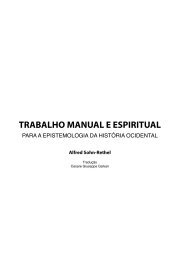Perversion the Social Relation
Perversion the Social Relation
Perversion the Social Relation
- No tags were found...
You also want an ePaper? Increase the reach of your titles
YUMPU automatically turns print PDFs into web optimized ePapers that Google loves.
"I Know Well, but All <strong>the</strong> Same .. ." 75that all my clan fa<strong>the</strong>rs and uncles were dancing as Katcinas. I felt <strong>the</strong>worst when I saw my own fa<strong>the</strong>r" (84). 8Indeed, what can one believe if authority is deception [mystification]}What is truly puzzling here is <strong>the</strong> fact that this ceremony of démystificationand <strong>the</strong> blow it deals to <strong>the</strong> children's belief in <strong>the</strong> Katcinas provide<strong>the</strong> institutional foundation for <strong>the</strong> new belief in <strong>the</strong>m that forms<strong>the</strong> heart of Hopi religion. Reality—<strong>the</strong> fact that <strong>the</strong> Katcinas are <strong>the</strong>initiates' fa<strong>the</strong>rs and uncles—has to be disavowed by way of a transformationof belief. Yet is this so puzzling after all? Do we not tend to finditnatural? "Now you know," <strong>the</strong> children are told, "that <strong>the</strong> real Katcinasdo not come to dance in <strong>the</strong> pueblos <strong>the</strong> way <strong>the</strong>y did in <strong>the</strong> old days.Now <strong>the</strong>y only come invisibly, and, on <strong>the</strong> days of <strong>the</strong> dance, <strong>the</strong>y dwellin <strong>the</strong>ir masks in mystical fashion." A Hopi Voltaire would doubtlessreply that, having been fooled once, he won't be fooled again! But <strong>the</strong>Hopis distinguish and contrast <strong>the</strong> way <strong>the</strong> children are deceived and <strong>the</strong>mystical truth into which <strong>the</strong>y are initiated. A Hopi can say in all goodfaith, in a way that is manifestly not quite identical to <strong>the</strong> formulationwe meet with in psychoanalysis, '7 know well that <strong>the</strong> Katcinas are notspirits; <strong>the</strong>y are my fa<strong>the</strong>rs and uncles. But, after all, <strong>the</strong> Katcinas arepresent when my fa<strong>the</strong>rs and uncles dance masked." 9 The formula "in<strong>the</strong> old days, people believed in masks" is not as simple as it seems. Ishall come back to <strong>the</strong> relationship between belief and imposture.Thus, after this trying experience, in which infantile beliefs are refuted,<strong>the</strong>se beliefs can continue to exist in adult form: something has,as it were, gone over to <strong>the</strong> o<strong>the</strong>r side (<strong>the</strong> definition of initiation). WhenTalayesva later falls ill and is saved by a tutelary spirit, <strong>the</strong> spirit appearsto him in <strong>the</strong> guise of a Katcina. At ano<strong>the</strong>r point, Talayesva takes pleasurein <strong>the</strong> thought that he will come back to dance as a Katcina in hispueblo after his death. But he also says something else: that all of thishas been a lesson to him, and that, from now on, he will take care todo what is right. We have here a reaction that recalls <strong>the</strong> establishmentof <strong>the</strong> superego; but it also and all but indiscemibly recalls <strong>the</strong> momentwhen belief, shedding its imaginary form, is symbolized sufficiently tolead on to faith, that is, to a commitment.Since some might ask, though <strong>the</strong> answer is obvious, about <strong>the</strong> questionof castration, it should be pointed out that this question arises forTalayesva too, both apparently and explicitly; but it arises elsewhere,








